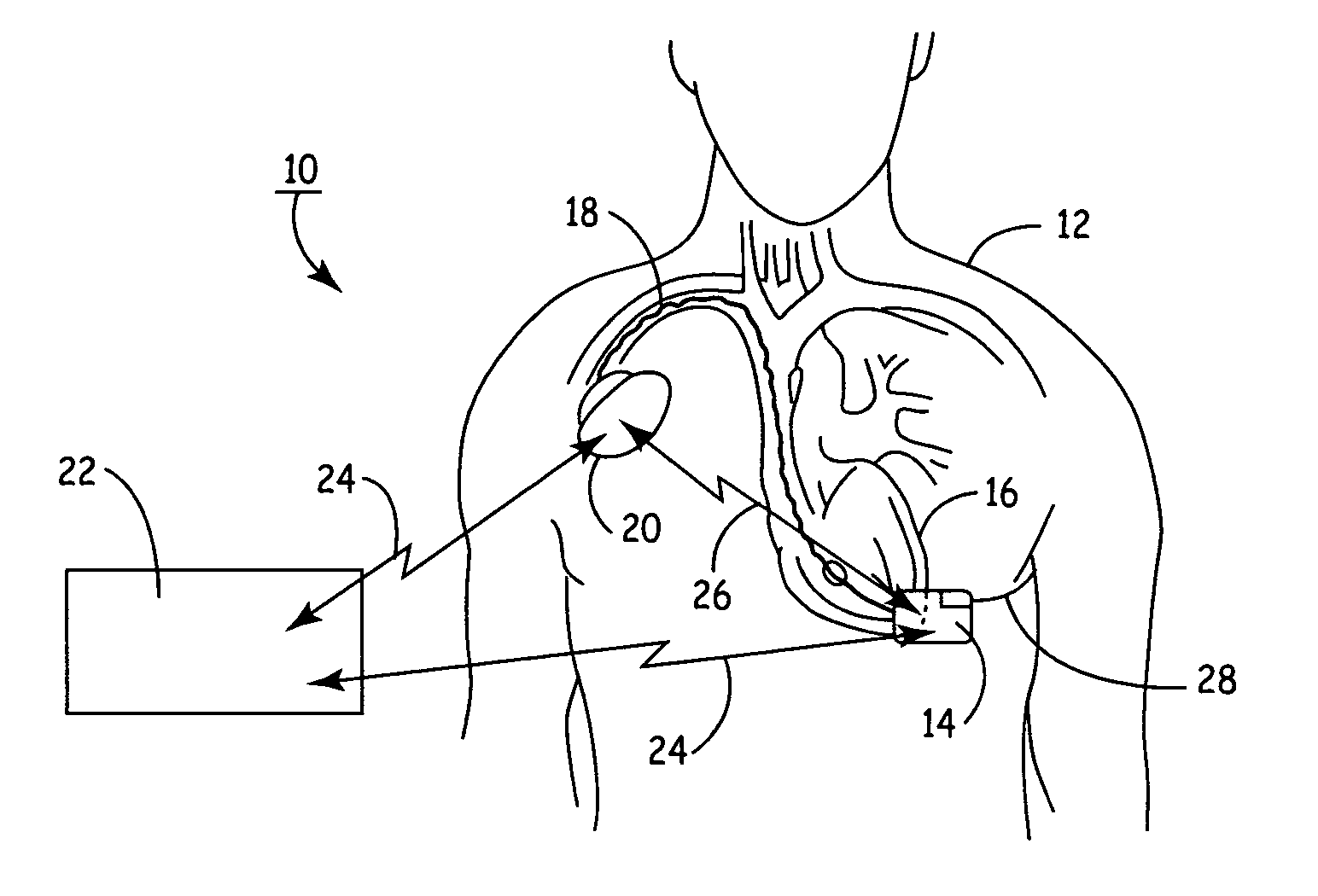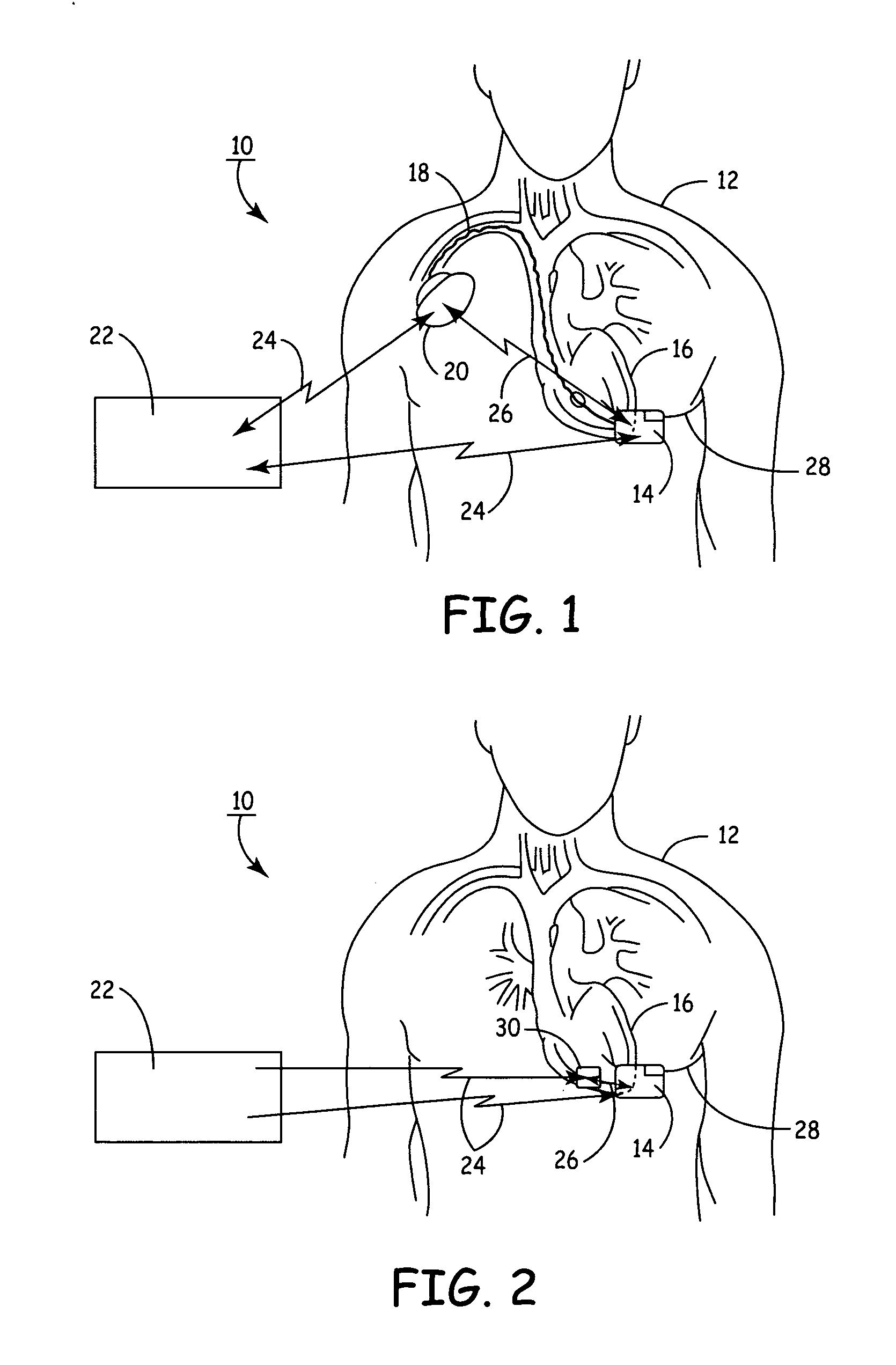Remotely enabled pacemaker and implantable subcutaneous cardioverter/defibrillator system
a technology of remote enabled pacemakers and implantable cardioverters, which is applied in the field of implantable medical devices, can solve the problems of prohibitively expensive implanting of currently available imds in all such patients, difficult to implant in some patients, and high cost of imds and implant procedures, so as to reduce pain and discomfort, and achieve safe and effective operations
- Summary
- Abstract
- Description
- Claims
- Application Information
AI Technical Summary
Benefits of technology
Problems solved by technology
Method used
Image
Examples
first embodiment
[0033]FIG. 1 illustrates the present invention, having a SubQ ICD 14 and IMD 20 implanted in patient 12. The SubQ ICD 14 is subcutaneously implanted outside the ribcage of patient 12 anterior to the cardiac notch. SubQ ICD 14 is shown coupled to subcutaneous lead 28. Lead 28 includes an electrode for subcutaneous sensing and cardioversion / defibrillation therapy delivery and is located transthoracically in relation to heart 16. Lead 28 is tunneled subcutaneously from the median implant pocket of SubQ ICD 14 laterally and posterially to the patient's back to a location opposite the heart such that the heart 16 is disposed between the SubQ ICD 14 and the distal electrode coil 29 (see FIG. 3). The implant location of device 14 and lead 28 is typically between the 3rd and 8th ribs.
[0034] IMD 20 is shown implanted pectorially in patient 12 and may take the form of any type of pacemaker / stimulator such as, but not limited to, a single chamber atrial pacemaker, a single chamber ventricular ...
second embodiment
[0037]FIG. 2 illustrates the present invention having SubQ ICD 14 and IMD 30 implanted in patient 12. The SubQ ICD 14 is subcutaneously implanted outside a patient's 12 ribcage similar to the description hereinabove.
[0038] IMD 30 is shown implanted epicardially in patient 12 and may take the form of any type of pacemaker / stimulator such as, but not limited to, a single chamber atrial pacemaker, a single chamber ventricular pacemaker, a dual chamber atrial / ventricular pacemaker, a bi-atrial pacemaker, a bi-ventricular pacemaker and the like. Cardiac leads / electrodes (not shown in FIG. 2) connect IMD 30 to the patient's heart 16 and may take the form of any typical lead configuration as is known in the art, such as, without limitation, epicardial right ventricular (RV) pacing leads, right atrial (RA) pacing leads, left ventricular pacing leads, unipolar or bipolar lead / electrode configurations, or any combinations of the above lead systems. Epicardial lead / electrode attachment to the ...
PUM
 Login to View More
Login to View More Abstract
Description
Claims
Application Information
 Login to View More
Login to View More - R&D
- Intellectual Property
- Life Sciences
- Materials
- Tech Scout
- Unparalleled Data Quality
- Higher Quality Content
- 60% Fewer Hallucinations
Browse by: Latest US Patents, China's latest patents, Technical Efficacy Thesaurus, Application Domain, Technology Topic, Popular Technical Reports.
© 2025 PatSnap. All rights reserved.Legal|Privacy policy|Modern Slavery Act Transparency Statement|Sitemap|About US| Contact US: help@patsnap.com



